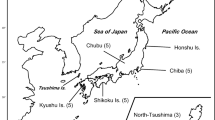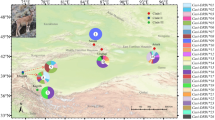Abstract
Allelic diversity at major histocompatibility complex (MHC) genes is thought to be maintained by balancing selection over long periods of time, even across multiple speciation events. Trans-species sharing of MHC alleles among genera has been supported by many studies on mammals and fish, but in rodents, the results are ambiguous. We investigated natural levels of MHC-DRB variability and evolutionary processes in the wood mouse (Apodemus sylvaticus) and the yellow-necked mouse (Apodemus flavicollis), which are common, sympatric murid rodents in European forests. Using single-strand conformation polymorphism analysis and DNA sequencing, 38 DRB exon 2 alleles were detected among 162 A. sylvaticus from nine different locations in Germany and Switzerland, and 15 DRB exon 2 alleles were detected among 60 A. flavicollis from three different locations in northern Germany. There was evidence for balancing selection in both species. Phylogenetic analysis, including additional murid taxa, showed that the DRB exon 2 sequences did not separate according to species, consistent with trans-species evolution of the MHC in these taxa.

Similar content being viewed by others
References
Apanius V, Penn DJ, Slev PR, Ruff LR, Potts WK (1997) The nature of selection on the major histocompatibility complex. Crit Rev Immunol 17:179–224
Benoist CO, Mathis DJ, Kanter MR, Williams VE III, McDewitt HO (1983) Regions of allelic hypervariability in the murine Aalpha immune response gene. Cell 34:169–177
Bernatchez L, Landry C (2003) MHC studies in nonmodel vertebrates: what have we learned about natural selection in 15 years? J Evol Biol 16:363–377
Brown JH, Jardetzky T, Saper MA (1988) A hypothetical model of the foreign antigen-binding site of class II histocompatibility molecules. Nature 332:845–850
Brown JH, Jardetzky TS, Gorga JC, Stern LJ, Urban RG, Strominger JL, Wiley DC (1993) Three-dimensional structure of the human class II histocompatibility antigen HLA-DR1. Nature 364:33–39
Catzeflis FM, Sheldon FH, Ahlquist JE, Sibley CG (1987) DNA–DNA hybridization evidence of the rapid rate of muroid rodent DNA evolution. Mol Biol Evol 4:242–253
Edwards SV, Hedrick PW (1998) Evolution and ecology of MHC molecules: from genomics to sexual selection. Tree 13:305–311
Edwards SV, Chesnut K, Satta Y, Wakeland EK (1997) Ancestral polymorphism of Mhc class II genes in mice: implications for balancing selection and the mammalian molecular clock. Genetics 146:655–668
Erlich HA, Bugawan TL (1990) HLA DNA typing. In: Innis MA, Gelfand DH, Sninsky JJ, White TJ (eds) PCR protocols. Academic, New York, pp 261–271
Frye MS, Hedges SB (1995) Monophyly of the order Rodentia inferred from mitochondrial DNA sequences of the genes for 12 S rRNA, 16 S rRNA, and tRNA-Valine. Mol Biol Evol 12:168–176
Gockel J, Harr B, Schlötterer C, Arnold W, Gerlach G, Tautz D (1997) Isolation and characterisation of microsatellite loci from Apodemus flavicollis (Rodentia, Muridae) and Clethrionomys glareolus (Rodentia, Cricetidae). Mol Evol 6:597–599
Harr B, Musolf K, Gerlach G (2000) Characterization and isolation of DNA microsatellite primers in wood mice (Apodemus sylvaticus, Rodentia). Mol Evol 9:1664–1665
Hedrick PW (2001) Conservation genetics: where are we now? Tree 16:629–636
Hedrick PW, Lee RN, Garrigan D (2002) Major histocompatibility complex variation in red wolves: evidence for common ancestry with coyotes and balancing selection. Mol Evol 11:1905–1913
Hess CM, Edwards SV (2002) The evolution of the major histocompatibility complex in birds. Bioscience 52:423–431
Hughes AL, Yeager M (1998) Natural selection at major histocompatibility complex loci of vertebrates. Annu Rev Genet 32:415–435
Janeway CA, Travers P, Walport M, Capra JD (1999) Immunobiology: the immune system in health and disease. Current Biology, London
Jonsson AK, Andersson L, Rask L (1989) Selection for polymorphism in the antigen recognition site of major histocompatibility complex class II molecules. Scand J Immunol 30:409–417
Jukes TH, Cantor CR (1969) Evolution of protein molecules. In: Munro HN (ed) Mammalian protein metabolism. Academic, New York, pp 21–132
Klein J (1986) Natural history of the major histocompatibility complex. Wiley, New York
Klein J (1987) Origin of major histocompatibility complex polymorphism: the trans-species hypothesis. Hum Immunol 19:155–162
Klein J, Bontrop RE, Dawkins RL, Erlich HA, Gyllensten UB, Heise ER, Jones PP, Parham P, Wakeland EK, Watkins DI (1990) Nomenclature for the major histocompatibility complexes of different species: a proposal. Immunogenetics 31:217–219
Kumar S, Hedges SB (1998) A molecular timescale for vertebrate evolution. Nature 392:917–920
Kumar S, Tamura K, Jakobsen IB, Nei M (2001) Molecular evolutionary genetics analysis, version 2.1., Arizona State University, Tempe
Martin Y, Gerlach G, Schlötterer C, Meyer A (2000) Molecular phylogeny of European muroid rodents based on complete cytochrome b sequences. Mol Phylogenet Evol 16:37–47
Michaux JR, Pasquier L (1974) Dynamique des populations de mulots (Rodentia, Apodemus) en Europe durant the Quaternaire. Prem Donn Bull Soc Geol France 7:431–439
Michaux JR, Chevret P, Filipucci MG, Macholán M (2002) Phylogeny of the genus Apodemus with a special emphasis to the subgenus Sylvaemus using the nuclear IRBP gene and two mitochondrial markers: cytochrome b and 12s rRNA. Mol Phylogenet Evol 23:123–136
Michaux JR, Magnanou E, Paradis E, Nieberding C, Libois R (2003) Mitochondrial phylogeography of the woodmouse (Apodemus sylvaticus) in the Western Palearctic region. Mol Evol 12:685–697
Misonne X (1969) African and Indo-Australian Muridae: evolutionary trends. Ann Mus R Afr Cent Tervuren Zoo 172:1–219
Münster M (2003) Molekulargenetische Untersuchungen zur Populationsdifferenzierung von Rattus rattus L. auf Madagaskar. Diploma thesis, Department of Animal Ecology and Conservation, University of Hamburg
Nei M (1991) Relative efficiencies of different tree making methods for molecular data. In: Miyamoto MM, Cracraft J (eds) Phylogenetic analysis of DNA sequences. Oxford University Press, New York, pp 90–128
Nei M, Gojobori T (1986) Simple methods for estimating the numbers of synonymous and nonsynonymous nucleotide substitutions. Mol Biol Evol 3:418–426
Nikoletopoulos NP, Chondropoulos BP, Fraguedakis-Tsolis SE (1992) Albumin evolution and phylogenetic relationships among Greek rodents of the families Arvicolidae and Muridae. J Zoo 228:445–453
Orita M, Suzuki Y, Sekiya T, Hayashi K (1989) Rapid and sensitive detection of point mutations and DNA polymorphisms using the polymerase chain reaction. Genomics 5:874–879
Penn DJ, Potts WK (1999) The evolution of mating preferences and major histocompatibility complex genes. Am Nat 153:145–164
Penn DJ, Damjanovich K, Potts WK (2002) MHC heterozygosity confers a selective advantage against multiple-strain infections. Proc Natl Acad Sci USA 99:11260–11264
Pfau RS, Van Den Bussche RA, McBee K, Lochmiller RL (1999) Allelic diversity at the Mhc-DQA locus in cotton rats (Sigmodon hispidus) and a comparison of DQA sequences within the family Muridae (Mammalia: Rodentia). Immunogenetics 49:886–893
Reutter BA, Petit E, Brünner H, Vogel P (2003) Cytrochrome b haplotype divergence in West European Apodemus. Mamm Biol 68:153–164
Richman AD, Herrera LG, Nash D (2003) Evolution of MHC class II Eß diversity within the genus Peromyscus. Genetics 164:289–297
Saitou N (1991) Book review: molecular systematics. In: David M Hillis, Craig Moritz (eds) Mol Biol Evol 4:559–561
Sambrook J, Fritsch EF, Maniatis T (1989) Molecular cloning: a laboratory manual. Cold Spring Harbor Laboratory, Cold Spring Harbor
Schad J, Sommer S, Ganzhorn JU (2004) MHC variability of a small lemur in the littoral forest fragment of southeastern Madagascar. Conserv Genet 5(3):299–309
Seddon JM, Ellegren H (2002) MHC class II genes in European wolves: a comparison with dogs. Immunogenetics 54:490–500
Serizawa K, Suzuki H, Tsuchiya K (2000) A phylogenetic view on species radiation in Apodemus inferred from variation of nuclear and mitochondrial genes. Biochem Genet 38:27–40
Sommer S (2003) Effects of habitat fragmentation and changes of dispersal behaviour after a recent population decline on the genetic variability of noncoding and coding DNA of a monogamous Malagasy rodent. Mol Evol 12:2845–2851
Van den Bussche RA, Hoofer SR, Lochmiller RL (1999) Characterization of Mhc-DRB allelic diversity in white-tailed deer (Odocoileus virginianus) provides insight into Mhc-DRB allelic evolution within Cervidae. Immunogenetics 49:429–437
Vestberg M, Brunsberg U, Bergsteinsdottir K, Karlsson M, Gustafsson K, Wedekind D, Hedrich H, Holmdahl R (1998) Limited polymorphism in the first domain of the rat MHC class II RT1-D molecule. Immunogenetics 48:344–349
Acknowledgements
We thank J.U. Ganzhorn for unflagging support and I. Tomaschewski for helping in the lab. Special thanks go to Anthony B. Wilson for much advice, helpful discussions, and comments on the manuscript. We appreciate the financial support provided by the Hanseatische Natur- und Umweltinitiative e.V. and the German Science Foundation (DFG).
Author information
Authors and Affiliations
Corresponding author
Rights and permissions
About this article
Cite this article
Musolf, K., Meyer-Lucht, Y. & Sommer, S. Evolution of MHC-DRB class II polymorphism in the genus Apodemus and a comparison of DRB sequences within the family Muridae (Mammalia: Rodentia). Immunogenetics 56, 420–426 (2004). https://doi.org/10.1007/s00251-004-0715-9
Received:
Revised:
Published:
Issue Date:
DOI: https://doi.org/10.1007/s00251-004-0715-9




